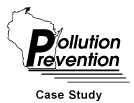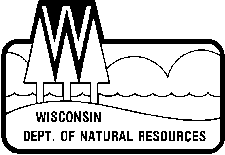
|
Miller Electric
Manufacturing Company
Replacing Solvent-based Paints
with Powder Paint |
| Standard Industrial Classification
(SIC) |
Electric and gas welding and soldering
equipment/3548 |
| Type of Waste |
Paint-related solid and hazardous wastes;
hazardous air emissions |
| Strategy |
Process line modification |
| Company Background |
Miller Electric Manufacturing Company of
Appleton, Wisconsin, is the world's largest manufacturer of arc welding equipment and
systems. Miller is a leading supplier to the metalworking, construction, and maintenance
markets. Founded in 1929, the company employs over 1,600 people and operates one million
square feet of manufacturing space in the Appleton area. The company was acquired by
Illinois Tool Works, Inc. in 1993 and now operates as a wholly- owned subsidiary. |
| Original Process |
Metal parts were coated on a liquid
painting conveyor line consisting of: five-stage parts washer; drying oven; four
electrostatic disk applicator booths; four manual spray gun booths; and a curing oven.
This system was installed in 1980. |
| Motivation |
The previous system used high-solids paint
and achieved a relatively high transfer efficiency. However, Miller had concerns about
future environmental regulations and wanted to reduce the costs of paint-related waste
disposal. In 1994, nearly 30 tons of Volatile Organic Compound (VOC) air emissions were
generated from liquid spray painting operations. Paint-related wastes were disposed of at
a cost of approximately $20,000. In addition to environmental issues, Miller sought to
improve the corrosion resistance of its painted parts. |
| Pollution Prevention Process |
Miller contacted a number of painting
equipment suppliers to find an environmentally benign, high performance painting system.
In late December of 1994, two powder booths were installed to replace the four
electrostatic disk applicator booths. The two booths utilize 24 automatic and four manual
guns. They are able to meet 80 percent of Miller's topcoat painting needs. The four manual
spray booths were retained for painting low volume special colors. |
| Stage of Operations |
Complete and in operation |
| Level of Commercialization |
The technologies described here are
commercially available |
| Material/Energy Balance |
Original Process
Feedstock
13,000 gallons per year of liquid paintWaste &
Disposal
60,000 pounds per year of paint-related wastes
Energy Use
330° F cure temperature using 2.4 million cubic feet/year of natural gas.
Pollution Prevention Process
Production increased approximately 5%.
Feedstock
80,000 pounds per year of powder paint
(equivalent to 9,000 gallons of paint)
Waste & Disposal
15,000 pounds per year of paint related wastes
(90 percent of waste is due to remaining liquid paint processes)
Waste reduction achieved (annual basis):
- 50,000 pounds of VOC air emissions
- 40,000 pounds of waste paint filters
- 5,000 pounds of hazardous waste paint and solvents
Energy Use
400° F cure temperature using 2.6 million cubic feet/year of natural gas. The increase in
energy use was offset by energy savings from the elimination of spray booth air flow. |
| Economics |
Capital Costs
$545,000 to purchase and install: powder paint system; environmentally controlled
application room; oven upgrades; and improvements to metal preparation and cleanup.Operation/Maintenance Costs
Total operating and maintenance costs were reduced by $87,000 per year with the new powder
painting process. This figure includes savings in purchasing and disposal costs.
Payback Period
Total cost of painting has been reduced by 25 percent, on a square foot of painted
surface basis, due to higher transfer efficiency achieved with the powder coat system. The
payback period has been calculated as 6.3 years. |
| Benefits |
This project was approved based on
predicted improvements in quality and environmental benefits. Powder painting of parts has
improved corrosion resistance significantly. The surface finish quality of the parts also
is superior to that achieved with the liquid painting process. Substantial reductions in
VOC air emissions and paint-related wastes have been achieved. Employees have benefited
from the elimination of solvent use. The powder booths and environmental room are
effective in controlling dust from the process. |
| Obstacles |
The conversion of the existing conveyorized
paint system to powder paint was accomplished over a holiday shutdown. Only very minor
start-up problems were encountered. Employee acceptance of the powder painting process has
been exceptional. Powder coatings will not work for all substrate
materials or part configurations. In addition, the high capital cost may be prohibitive
for small shops. Other pollution prevention measures may need to be investigated in these
situations. |
| Technology Transfer |
Miller is willing to provide tours of its
facility and share its expertise on powder coating with others. An article on Miller's
powder system was published in the May 1995 corporate newsletter which is distributed to
over 250 of its worldwide business units. |
| Other Pollution Prevention
Activities |
Miller has replaced organic solvent cold
cleaners with aqueous systems for all high volume metal parts cleaning. In addition,
Miller has replaced conventional solvent-based insulating varnish for electromagnetic
assemblies with very low VOC resins in several applications. |
| Company Address |
Miller Electric Manufacturing Company
1635 West Spencer Street
Appleton, Wisconsin 54914 |
| Contact Person |
Ken Brown, Senior Environmental Engineer
Phone: 414/735-4472
FAX: 414/735-4180 |
| Pollution Prevention Resources |
Free, On-site Technical Assistance
University of Wisconsin Extension
Solid and Hazardous Waste Education Center
Milwaukee area: 414/475-2845
Remainder of state: 608/262-0385Pollution Prevention
Information Clearinghouse
Wisconsin Department of Natural Resources
Hazardous Waste Minimization Program
608/264-8852, 608/267-9523 or 608/267-3763 |
 |
Bureau of Cooperative Environmental Assistance
Wisconsin Department of Natural Resources
P.O. Box 7921
Madison, WI 53707
608/267-9700
PUBL-TS-055 |
|

